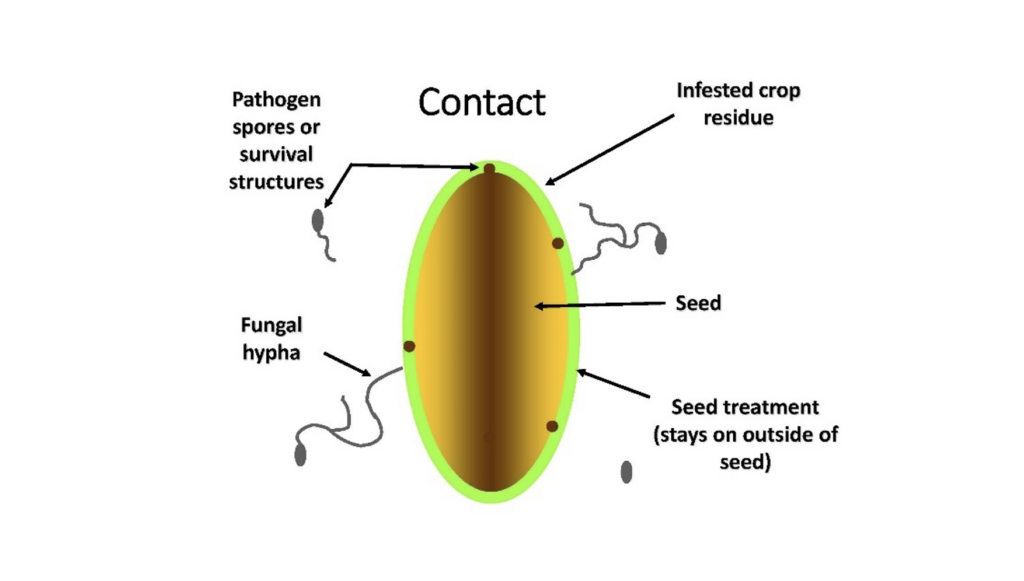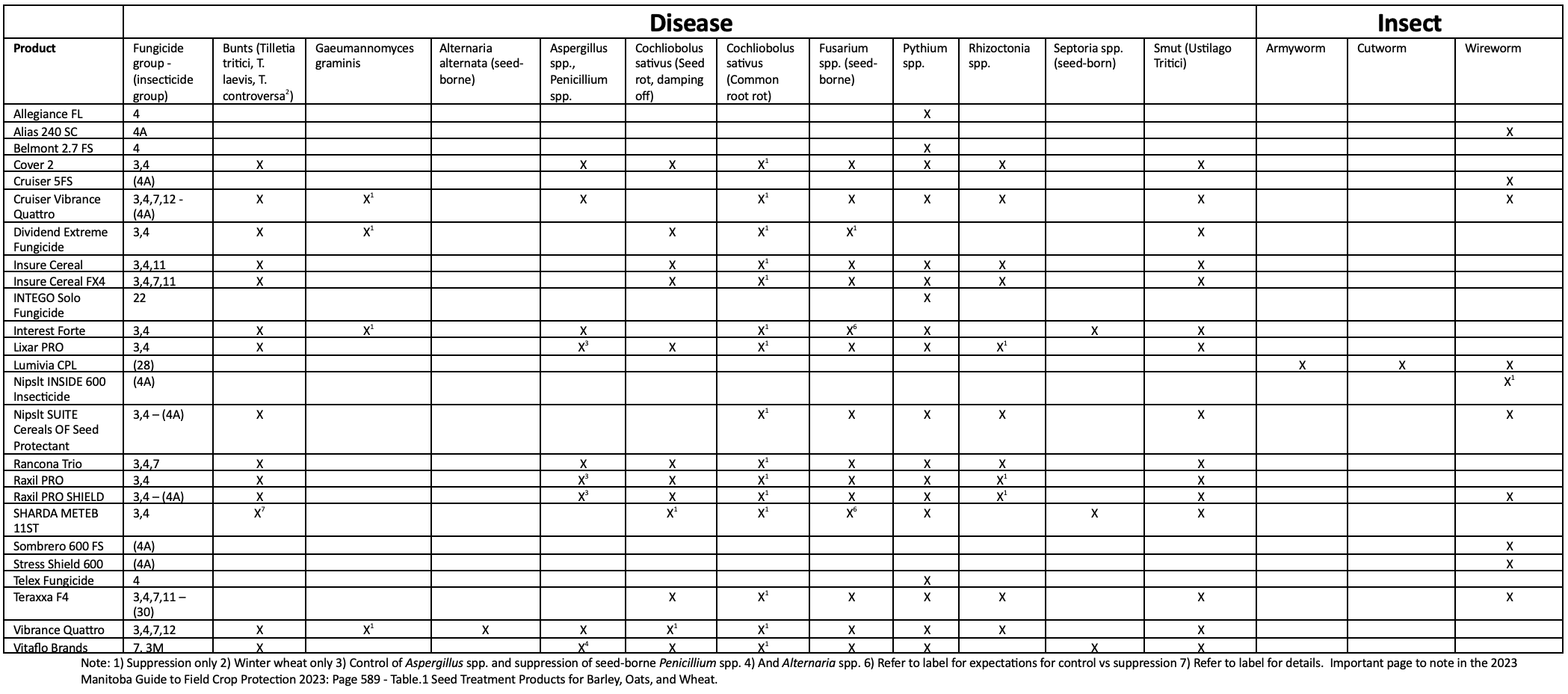Section Title
Seed treatments in wheat, barley and flax: what they are, how they work and when they should be used
- Flax
- Wheat
Seed treatments are commonly used across Manitoba on numerous crop types. Here is more information about how they work and what pests they target in wheat, barley and flax.
What they are
Seed treatments are crop input products applied to seeds prior to seeding. The seed treatment coats the seed, providing a protective layer against seed and seedling pests. Seed treatments assist in the control or suppression of plant pathogens and insects that are harmful to seed and seedling health. Seed and seedling diseases can have detrimental effects, including seed death, pre-emergence death and post-emergence death. Additionally, seed treatments can maintain or preserve seed quality. Some farmers use seed treatments annually, never or make decisions to use them depending on risk factors, such as seedbed conditions, disease risk, seed quality and weather. It is necessary to understand the basics of seed treatments to make on-farm production decisions.
However, it’s important to note that seed treatments cannot improve seed quality and are not a solution to all disease and insect issues. Instead, they are a tool that can be used in tandem with other integrated pest management practices, such as diverse crop rotations, disease-free seed, seed testing, foliar fungicides, bio-control practices and residue management, to give crops the best chance for success. Also, seed treatments provide protection for a short duration of time, not throughout the entire growing season. For example, seed treatments will provide negligible protection against root rot infections later in the growing season.
How they work
Just like herbicides, foliar fungicides and foliar insecticides, there are several types of seed treatments, which utilize different modes of action. There are two broad seed treatment categories: systemic/eradicant and contact. Almost all seed treatments contain a fungicide component for diseases, while some contain insecticide components (dual seed treatment) or are insecticide-only seed treatments. Complete coverage of seeds with the seed treatment is required for products to be most effective.
Contact Fungicides: Contact seed treatments are also referred to as protectants. These seed treatments coat the outside of the seed and do not provide action on spores that have already germinated or embryo infections1. This type of seed treatment provides protection against fungal pathogens that are encountered after seed treatment application (i.e., pathogens that are soil-borne or on the seed surface, such as common root rot)1. Refer to Figure 1 for visual depiction of a contact seed treatment.

Figure 1. Diagram of possible points of fungal infection and the position of the contact seed treatment. Diagram provided by Kelly Turkington, Agriculture and Agri-Food Canada.
Systemic Fungicides: Systemic seed treatments have multiple mechanisms to protect seeds and seedlings. They provide protection like contact seed treatments but are also mobile and move through the seed and partially into the growing plant tissue1. Therefore, these seed treatments can be effective on pathogens that are seed-borne, such as seed coat and embryo inflections1 (e.g., true loose smut). Systemic seed treatments can prevent disease from occurring and kill pathogens that have already infected the seed/plant. These seed treatments are also known as eradicants, although complete eradication does not commonly occur. Systemic seed treatments have limited continued effects, but do not protect plants beyond the seedling stage. Refer to Figure 2 for visual depiction of a systemic seed treatment.

Figure 2. Diagram of possible points and causes of fungal infection on a seed and the position of systemic seed treatments. Diagram provided by Kelly Turkington, Agriculture and Agri-Food Canada.
Insecticides: Insecticide components of seed treatments are usually systemic but provide both systemic and contact modes of action (e.g., wireworms).
Target pests
Seed treatments target diseases that reside on/in the soil (soil-borne), on/in the seed (seed-borne) or on crop residues. Seedling and seed diseases are the primary target of the fungicide component of seed treatments. Insects are also targeted using seed treatments. Wireworms, armyworms and cutworms are the only insect pests of wheat and barley targeted with registered seed treatments in Manitoba.
Table 1. Summary of select wheat and barley seed and seedling diseases, their symptoms and management options.
| Common Name (if applicable) | Disease (Crop) | Disease Symptoms and Indicators | Best Management Practices |
| Leaf Stripe | Pyrenophora graminea (Barley) | Leaf disease, where the fungus overwinters in or on the seed1. Leaves exhibit yellow or yellowish green longitudinal stripes, bound by leaf veins. The striped tissue browns and tears. Infected plants are often stunted, and heads fail to emerge1. | Seed into warm soils (>15 °C), fungicide seed treatment, clean and disease-free seed1.
|
| Loose Smut | Ustilago tritici (Wheat), Ustilago nuda (Barley) | Similar in appearance to false loose smut. The infected head emerges at similar timing as healthy plants but has a smutted head1. The head breaks down and the spores are released, leaving an exposed central stalk. The spores are not quite as dark as false loose smut. The fungus overwinters on and in the seed embryo1. The fungus develops and penetrates the developing seed, then goes dormant until the next growing season. This is a seed-borne disease. | Resistant cultivars, systemic fungicide seed treatment, smut free seed.
|
| Covered and False Loose Smut | Ustilago hordei, U. nigra (Barley) | Covered Smut: Stunted infected plants with a smutted head which appears through the sheath under the boot leaf. Heads are hard and have deformed chaff and awns1. This is a seed-borne/seed-surface borne disease.
False Loose Smut: Looks like loose smut. A smutted head emerges at a similar height as infected heads1. Smutted heads are initially covered with a fine grey membrane, but eventually this membrane is removed, and the spores are released via wind and rain1. The central stalk remains exposed after spores are released. This is a seed-borne/seed-surface borne disease. |
Resistant cultivars, fungicide seed treatment, smut free seed1.
|
| Take-all | Gaeumannomyces graminis (Barley/Wheat) | Plants are often stunted, white, and will die prematurely. White heads are a distinct feature and are often found in clumps1. The heads do not contain seeds, or the seeds are deformed and dark in colour. Roots are usually very brown to shiny black1. The plant can be pulled from the ground easily. It can also be distinguished by its shiny black appearance of the fungal growth on the stem1. | Diverse rotation, with non-host crops (ex. Canola), adequate levels of P and K to promote root growth. Control volunteers and grassy weeds (alterative hosts), seed treatment1. |
| Alternaria alternata – seed borne (Barley/Wheat) | This pathogen causes dark kernel discolouration or kernel smudge. It is a black mold that favours warm and moist conditions1. | Clean seed, seed treatment (limited product options)1. | |
| Aspergillus spp., Penicillium spp. (Barley/Wheat) | These are storage molds. The mold develops post-harvest in storage. Germination is not affected. | Apply seed treatment if there are high disease levels. | |
| Seed Rot, Damping-Off | Cochliobolus sativus (Barley/Wheat) | Poor emergence. Seedlings that emerge have brown spots and seedlings may die shortly after1. Typically, symptoms and infected plants are scattered across the field. This can cause pre and post emergence damping-off. Not typically found in patches. | Crop rotation, fungicide seed treatment, clean seed1. |
| Common Root Rot | Cochliobolus sativus (Barley/wheat) | This disease shows minimal above ground symptoms, rather symptoms will be found on the crown and sub-crown internode1. Small brown lesions, which elongate to form large lesions up the leaf sheath. Not typically found in patches1. | Crop rotation to non-host crops, shallow seeding, clean seed, fungicide seed treatment, proper P and K fertilization.
|
| Seedling Blight | Fusarium spp. – seed-borne (Barley/Wheat) | This pathogen can cause severe seedling disease. These fungal species are a part of the common root rot and seedling blight complex; thus, similar symptoms are exhibited1. The same fusarium species causes fusarium head blight. | Seed treatment, disease-free seed, test seed for Fusarium spp. and Fusarium graminearum levels1. |
| Browning Root Rot, Pythium Root Rot | Pythium spp. (Barley/Wheat) | Primarily a seedling disease, which reduces plant stand establishment and delays maturity. Symptoms include lower leaves that become yellow, and brownish. Damping-off (sudden seedling death) is another common symptom1. This disease is usually found in patches. | Improve soil drainage and aeration, apply P fertilizer to recommended rates, fungicide seed treatment1. |
| Rhizoctonia spp. (Barley/Wheat) | This is pathogen can cause delayed plant growth, stunted growth, bare patches, and cause plant death. The fungus attacks the root tips, restricting nutrient and water uptake1. Roots tips are made into a point. Mostly a soil-borne disease. | Seed treatment, control of alternative host plants1. | |
| Septoria spp. – seed-borne (Barley/Wheat) | These pathogens cause leaf spotting and blotches1. Initial symptoms include yellow flecks on bottom leaves, which grow, elongate, and change colour to yellow, greyish, white, or brown blotches. Furthermore, lesions develop longitudinally, restricted by leaf veins. Lesions have parallel sides and blunt ends1. Wet, windy weather plus temperatures between 15 – 27 °C favour disease outbreaks1.
|
Clean seed, seed treatment for overall plant health, foliar fungicides1.
|
|
| Bunt | Tilletia tritici, T. laevis, T. controversa (Wheat) | Cool soil conditions favour infection. Disease symptoms are very difficult to identify until maturity. Infected plants may be moderately stunted. The kernels are replaced with greyish, brown bunt balls, which grow larger than the normal kernel, causing glumes to burst open1.
Common bunt is sometimes referred to as stinking smut, because of its distinct fishy odor when bunt balls rupture1. |
Resistant varieties, bunt-free seed, fungicide seed treatment.
|
Note: P = phosphorus; K = potassium.
Table 2. Summary of common flax seedling diseases, their symptoms, and management options.
| Common Name (if applicable) | Disease (Crop) | Disease Symptoms | Best Management Practices |
| Seedling Blight, Root Rot | Fusarium spp., Pythium spp., Rhizoctonia solani | Blighted seedlings turn yellow, wilt and die. Single plants, patches or gaps in the row. Roots have red or brown lesions, dark, shriveled. Flowering plants may wilt on hot days and turn brown prematurely. | Certified seed, seed treatment, crop rotation. |
Available options
There are numerous seed treatment options available to farmers. Treatments can be classified as broad spectrum or narrow spectrum. Broad spectrum seed treatments typically have multiple modes of action, allowing multiple pathogens to be targeted. Alternatively, narrow spectrum products affect select pathogens or insects. It is important to carefully read the product label to know which diseases and insects are targeted. Seed treatment components also differ between products. There are products with only a fungicide component, ones with only an insecticide component and dual seed treatments with a fungicide and insecticide component. Below are three tables with the registered seed treatment product options for wheat, barley and flax from the 2023 Manitoba Guide to Field Crop Protection.
Table 3. Seed treatment products registered for use on barley and the diseases and insects they target. Data from the Manitoba Guide to Field Crop Protection 2023.
Table 4. Seed treatment products registered for use on wheat and the diseases and insects they target. Data from the Manitoba Guide to Field Crop Protection 2023.
Table 5. Seed treatment products registered for use on flax and the diseases they target. Data from the Manitoba Guide to Field Crop Protection 2023.
When they should be used
Evaluating the need for seed treatments requires you to consider your own risk tolerance and the agronomic strength of your cropping system, and assess seed and seedling pest risks. This can help you make a seed treatment decision that optimizes your crop production system.
Things to consider:
- Seed quality and vigour – Planting disease-infected seed can be very detrimental to seed germination, plant emergence and overall plant health. This can lead to suppressed plant populations, weaker plants, reduced yields, and seed and seedling death. Also, check if the seed has any mechanical damage, as this can also have negative effects on survival.
- Variety disease resistance ratings – What are the seed and seedling disease resistance levels of your selected variety? Varieties have varying levels of resistance to common seedling diseases (e.g., barley – root rot, loose smut and surface borne smut; wheat – loose smut and common bunt). Cultivar resistance levels can be found here, in the Seed Manitoba Variety Selection and Growers Source Guide. Farmers must weigh many variables, such as yield potential, lodging resistance, disease resistance and days to maturity, when selecting a variety, but using a variety with some disease resistance is another layer in an integrated approach to pest management.
- Field history – Understanding potential risks, such as disease levels, pest pressures and prior crop rotations, provides insight into the need for seed treatment and what type. For example, if the field has been in a tight rotation with wheat and you are planting wheat, then that crop is at a higher risk for disease infection. Also, if wireworm infestation had occurred in that field, then there is a higher risk wireworm feeding will occur again, and an insecticide seed treatment may be warranted.
- Weather, soil conditions and seeding practices – Soils that are cool and wet can increase the risk of infection by seed- and soil-borne diseases. For example, Pythium thrive in cool and waterlogged soils. Furthermore, cool soils may delay seed germination, giving the pathogen more time to infect the seed or seedling, although wet and cool soil conditions are not a requirement for all seedling diseases. The soil conditions at seeding should also be considered, as good seed-to-soil contact is necessary for seeds to germinate and emerge quickly. If seeds are planted deeply, there may be an increased risk of seed and seedling diseases, as it typically takes longer for the plant to emerge.
The considerations mentioned above are some factors that can help evaluate potential risks and determine whether a seed treatment is warranted for your operation. Furthermore, when selecting a seed treatment check the products targeted pests, as targeted pests differ between seed treatments. Even in cases where risk factors are minimal, some view seed treatments as an insurance policy for unpredictable spring growing conditions, providing extra protection should unfavourable conditions materialize.
Seed treatments cannot be applied universally with all application systems. Ensure you consult the product label and the Manitoba Guide to Crop Protection, and contact chemical company representatives about whether a product can be applied using your application setup. Before applying a product, always calibrate and test your application system to ensure proper rates and uniform seed coverage. Always follow label instructions, rates and guidelines when applying product.
Select research trial findings
There have been multiple research studies that have investigated the use of seed treatments in small grains across different production systems in Western Canada. One small plot study by Brian Beres at Agriculture and Agri-Food Canada (AAFC) Lethbridge found that applying a dual seed treatment (fungicide and insecticide) improved winter wheat yield compared to non-treated seed when the cropping system was considered weak (i.e., light seed and low seeding rates) or when there was a thinner wheat stand2. A study by Kelly Turkington at AAFC Lacombe found that the inclusion of fungicide or a dual seed treatment on winter wheat improved net revenues and yield3. Additionally, Andrew Friskop from North Dakota State University found that, across 183 replicated treatments, the use of a fungicide seed treatment improved hard red spring wheat plant stands by 8.4 per cent on average4.
On-farm research trials investigating the use of seed treatments have also been conducted through the Manitoba Crop Alliance (MCA) Research on the Farm Program. Trials have been conducted on both wheat (2020-23) and barley (2023). The results have been mixed so far. In the wheat trials, significant yield differences were observed at three of the 23 total trial sites, with the treated seed having higher yields at these three sites. No significant yield differences were observed in the barley trial. More information on these trials or any MCA on-farm research can be found here.
In 2023, Manitoba Crop Alliance commenced a three-year flax seed treatment evaluation project, looking at two registered seed treatments on a brown and a yellow flax variety. The objective of the trial is to evaluate the efficacy of these seed treatments against soil-borne diseases in flax. Furthermore, we want to evaluate the relationship between the treatment and germination, emergence and yield of the two seed-types. Find more information on this trial here.
References
- Bailey KL, Gosen BD, Gugel RK, Morrall RAA. Diseases of Field Crops in Canada. 3rd ed. Saskatchewan (SK). The Canadian Phytopathological Society; 2003. 290 pp.
- Beres BL, Turkington TK, Kutcher HR, Irvine B, Johnson ER, O’Donovan JT, Harker KN, Holzapfel CB, Mohr R, Peng G, Spaner DM. Winter Wheat Cropping Systems Response to Seed Treatments, Seed Size, and Sowing Density. Agronomy Journal. 2016; 108(3): 1101-1111.
- Turkington TK, Beres BL, Kutcher HR, Irvine B, Johnson ER, O’Donovan JT, Harker KN, Holzapfel CB, Mohr R, Peng G, Stevenson FC. Winter Wheat Yields Are Increased by Seed Treatment and Fall-Applied Fungicide. Agronomy Journal. 2016; 108(4): 1379 – 1389.
- Friskop A. Wheat – Fungicide Sed Treatments (04/28/22) [Internet] North Dakota (ND). North Dakota State University [2022 April 28; 2024 Jan 15]. Available from: Wheat – Fungicide Seed Treatments (04/28/22) | NDSU Agriculture












